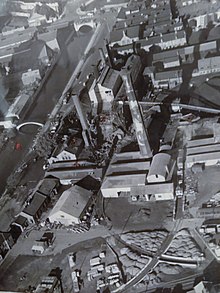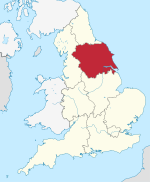| Foss Island Power Station | |
|---|---|
 | |
| Country | England |
| Location | North Yorkshire, Yorkshire and the Humber |
| Coordinates | 53°57′36″N 1°04′05″W / 53.960°N 1.068°W / 53.960; -1.068 |
| Commission date | 1900 |
| Decommission date | 1976 |
| Owners | York Corporation (1900–1948) British Electricity Authority (1948–1955) Central Electricity Authority (1955–1957) Central Electricity Generating Board (1958–1976) |
| Operator | As owner |
| Thermal power station | |
| Primary fuel | Coal |
| Turbine technology | Steam turbine |
| Chimneys | 1 |
| Cooling towers | 1 |
| Cooling source | River water and Cooling Tower |
| Power generation | |
| Units operational | 40 MW |
| Units decommissioned | All |
| Nameplate capacity | 40 MW |
| Annual net output | 54.77 GWh (1971–72) |
| [edit on Wikidata] | |
Foss Island Power Station, also known as York Power Station, was a small 40 MW coal-fired power station serving the city of York.
It was located in the Layerthorpe area of the city, to the east of the city centre.
It was built by York Corporation in the 1890s, opened in February 1900 and closed on 25 October 1976.


History
In 1923 the station was supplying 3-phase AC at 400 and 230 V; DC at 460 and 230 V; and DC for traction at 500 V. The steam turbine driven AC generators comprised two 1,250 kW and two 3,500 kW machines. DC current was produced by two 500 kW oil-driven machines. Electricity supplies were supplemented by a water powered generating station near Linton-on-Ouse (Linton Lock Hydro), which was commissioned in 1923 and comprised a 250 kW and a 500 kW generator. In 1923 the facilities at York generated 15.128 GWh of electricity. The sales of electricity produced a surplus of revenue over expenses of £26,938 for the Corporation.
Boiler Explosion – 1949
Source:
On 27 October 1949 at 4.23 a.m. the No. 1 Low Pressure Boiler exploded. This took place on the centre mid drum which ripped along its longitudinal seam. Sections were blown 50 yards away.
The rear boiler section and economiser were blown into the turbine hall causing 35 and 20 ton overhead cranes to collapse, writing off a 3,500 KW turbo alternator and 1,000 KW motor generator set.
The south end of the boiler house was completely wrecked.
Power was restored to York 9.20 p.m. from the remaining generator sets the same day.
Partial demolition of the station building was followed by reconstruction which was completed by August 1950.
The turbine house was in full working order by January 1951
Plant specification
The steam plant at Foss Island were chain grate stoker boilers capable of delivering 400,000 lb/h (50.4 kg/s) of steam at 400 psi (27.6 bar) and 399/427 °C. The generating capacity of the station was 40 MW. Steam condensing and cooling was by river water and a single concrete cooling tower. In the year ending 31 March 1972 the station delivered 54.772 GWh of electricity, its load factor (the average load as a per cent of maximum output capacity) was 16.4 per cent.

The electricity output from the station, in GWh, was as follows.
| Graphs are unavailable due to technical issues. Updates on reimplementing the Graph extension, which will be known as the Chart extension, can be found on Phabricator and on MediaWiki.org. |
In 1958 the York electricity district supplied an area of 166,179 acres and a population of 152,269. The amount of electricity sold and the number and types of consumers was as follows:
| Year | Electricity sold, MWh | No. of consumers |
|---|---|---|
| 1956 | 187,527 | 50,114 |
| 1957 | 197,137 | 51,362 |
| 1958 | 210,417 | 52,675 |


In 1958 the above totals were made up of the following:
| Type of Consumer | No. of consumers | Electricity sold, MWh |
|---|---|---|
| Residential | 46,254 | 87,671 |
| Shops, offices, etc. | 4,895 | 36,276 |
| Factories | 256 | 76,195 |
| Farms | 1,238 | 7,025 |
| Public lighting | 32 | 3,250 |
| Total | 52,675 | 210,417 |


The buildings were demolished around 1980 and the transmission line which ran from the power station to a substation at Tang Hall Lane was dismantled at around the same time.



References
- Jackson, Jeffrey (10 August 1961). "Why Boliers Corrode". New Scientist. No. 247. p. 334. Retrieved 17 January 2016.
- "The Derwent Valley Railway". www.irsociety.co.uk. Retrieved 17 January 2016.
- "Public services British History Online". www.british-history.ac.uk. Retrieved 17 January 2016.
- "Coal-fired Power Stations (Hansard, 16 January 1984)". Parliamentary Debates (Hansard). 16 January 1984. Retrieved 17 January 2016.
- ^ Electricity Commissioners (1925). Electricity Supply – 1920–1923. London: HMSO. pp. 106–09, 332–37.
- 1950 British Electricity Authority interim report into boiler explosion of 1949.
- CEGB (1972). CEGB Statistical Yearbook 1972. London: CEGB. p. 15.
- ^ Garrett, Frederick C., ed. (1959). Garcke's Manual of electricity supply vol. 56. London: Electrical Press. pp. A-110, A-139, B-261–262.
- CEGB Annual report and Accounts, 1961, 1962 & 1963
- Electricity Commission, Generation of Electricity in Great Britain year ended 31st December 1946. London: HMSO, 1947.
| Electricity generation in Yorkshire and the Humber | ||||||||||||||||||||||||||||||||||||||
|---|---|---|---|---|---|---|---|---|---|---|---|---|---|---|---|---|---|---|---|---|---|---|---|---|---|---|---|---|---|---|---|---|---|---|---|---|---|---|
| Power stations |
|  | ||||||||||||||||||||||||||||||||||||
| Organisations | ||||||||||||||||||||||||||||||||||||||